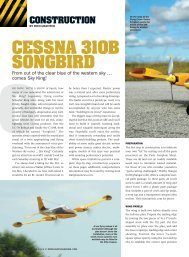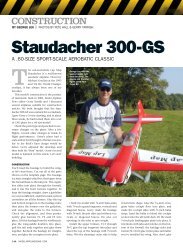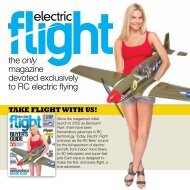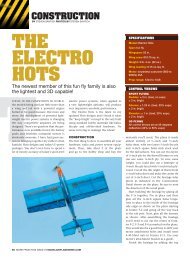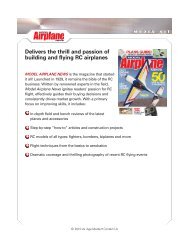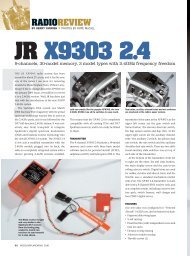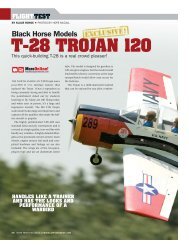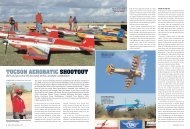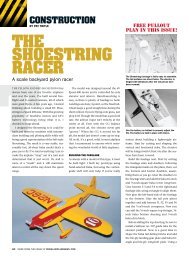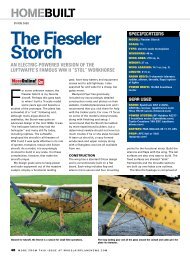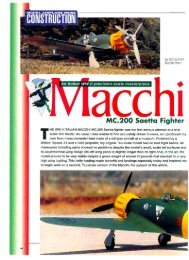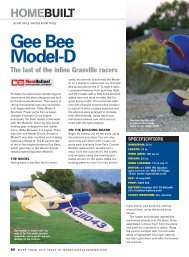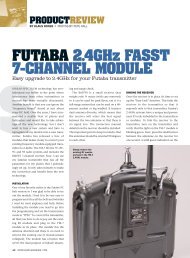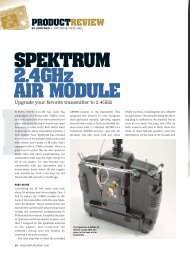You also want an ePaper? Increase the reach of your titles
YUMPU automatically turns print PDFs into web optimized ePapers that Google loves.
The Co-Pilot is a two-axis, four-sensor<br />
control-stabilization system that plugs<br />
into your RC system. It has no moving<br />
parts and uses infrared (IR) heat sensors to<br />
control the model's roll and pitch. The<br />
system has two components: a sensor<br />
head that you attach to the underside of<br />
your model and a controller unit that you<br />
install inside your model like a receiver. A<br />
thin ribbon cable connects the two. Two<br />
wire leads are connected to the controller;<br />
one has a push-button switch, and the<br />
other ends with a servo-lead connector.<br />
You use the switch when you calibrate the<br />
unit before each flight session, and the<br />
servo lead can be plugged into an unused<br />
radio channel in your receiver for in-flight<br />
on/off function.<br />
The Co-pilot comes with a wellillustrated<br />
instruction booklet that shows<br />
various installations. The instructions show<br />
in detail how to install the unit in a normal<br />
fixed-wing airplane, in a flying wing and in<br />
a helicopter. Here's how it works.<br />
The sensor head has four<br />
IR heat sensors that face left,<br />
right, forward and aft. The<br />
sensors read how much IR<br />
heat is present in the four<br />
directions. The controller<br />
unit evaluates the IR heat<br />
information and adjusts the<br />
controls to keep the IR heat<br />
values equal for all four sensors<br />
for normal straight-andlevel<br />
flight. Infrared heat is a<br />
much better source for control<br />
input than visible light<br />
because IR heat isn't affected<br />
as much by cloud cover.<br />
The controller is plugged into the RC<br />
receiver system between the receiver and<br />
the servos. Once it has been calibrated,<br />
the unit need not be calibrated again<br />
unless the weather changes drastically.<br />
Above: the controller unit is smaller than a standard<br />
receiver and is plugged into the radio system<br />
between the servos and the receiver.<br />
Right: the FMA Co-Pilot sensor head is held in<br />
place on the belly of the model with a piece of<br />
hook-and-loop fastener. Note the ribbon wire<br />
leading inside the model to the controller unit.<br />
Below: with the model standing on its nose, simply<br />
press the calibration switch; the controller<br />
unit does the rest. Note<br />
that the sensor head on<br />
the model's belly is facing<br />
away from me during<br />
the procedure.<br />
Since the unit<br />
works by reading<br />
the differences in IR<br />
heat levels rather<br />
than in light intensity,<br />
it works equally<br />
well in bright<br />
sunlight or overcast<br />
conditions. The<br />
unit will also work<br />
at night, though the inability to see your<br />
model is a limiting factor.<br />
It takes only a few minutes to install<br />
the units; you'll need to cut a small opening<br />
in the bottom of the fuselage so you<br />
High-performance applications by Rick Bell<br />
I wanted to see how the FMA Co-Pitot performed in a model other than a trainer,<br />
so I installed it in a Hangar 9 Advance 40. On the day I flew it, the weather was<br />
partly cloudy with temperatures in the mid-50s, and the wind was about 7- to<br />
13mph. I set up the unit to control the elevators and ailerons to allow me to<br />
turn it off during the flight if something went wrong. I connected the remote<br />
sensitivity lead to the retract gear switch.<br />
Cautiously, I took off with the unit turned off. At a safe altitude, I turned it<br />
on, let go of the sticks and waited to see what would happen: the plane contin-<br />
ued to fly straight and level. I could see the wind rock the wings, but the unit<br />
always returned them to level-pretty cool! With more confidence in the system,<br />
I turned the plane around for another pass and could feel the unit "fighting" my<br />
control inputs.<br />
On the next pass, I rolled the plane into knife-edge flight and, again, let go<br />
of the sticks. As before, the plane returned to level flight—this was getting inter-<br />
can pass the ribbon wire through to connect<br />
the sensor head to the controller.<br />
This takes only about 2 minutes.<br />
CALIBRATING THE UNIT<br />
Before the first flight of the day, you'll have<br />
to calibrate the unit to read the ambient IR<br />
heat; this is a two-step procedure. First,<br />
place the model's nose on the ground with<br />
its tail sticking straight up and the sensor<br />
head facing away from you. Turn on the<br />
transmitter and receiver and then press the<br />
push-button IR calibration switch. The control<br />
surfaces will then quickly deflect several<br />
times; the number of deflections tells you<br />
esting! On the next pass, I rolled the plane inverted and let go of the sticks; the<br />
plane immediately corkscrewed back to upright and level flight. I did this several<br />
more times, and the plane always returned to upright and level flight without<br />
any input from me. Don't do this at low altitude! When the plane is inverted, the<br />
unit applies up-elevator, and the plane does a split-S back to straight and level.<br />
I think ft would be better if instead the unit rolled the plane upright without<br />
elevator input.<br />
I was quite impressed during landing approaches; as the speed decreased,<br />
the plane settled nicely, and the nose and the wings remained level. I needed<br />
to use throttle only to make the approach to the runway and rudder to compen-<br />
sate for the crosswind; the Co-Piiot made landings really easy.<br />
The Co-Pilot works as advertised. Whether you use it in a high-performance<br />
model or in a .40-size trainer, Co-Pilot removes much of the risk, and this, con-<br />
sequently greatly enhances the RC experience.<br />
JUNE2DD2 75



